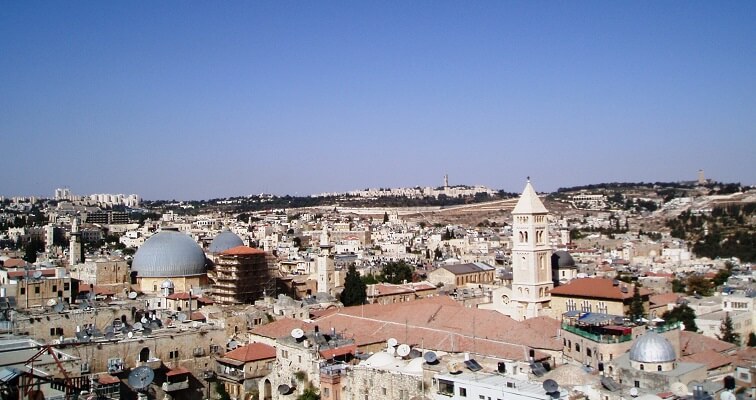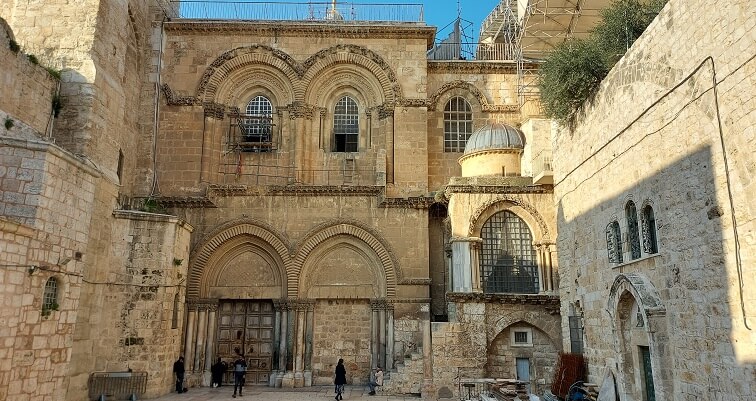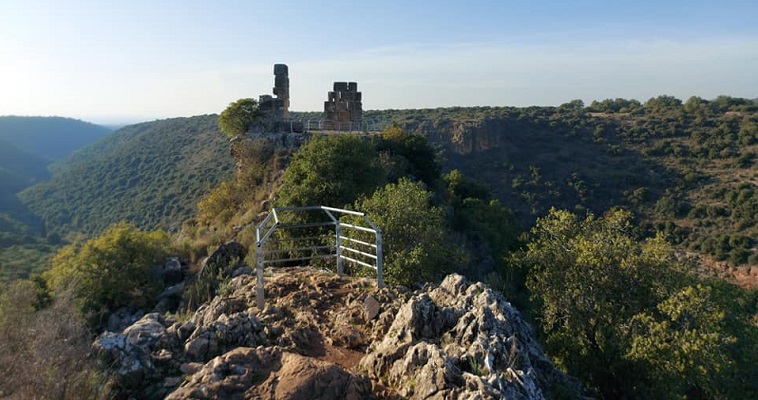The First Crusader Kingdom of Jerusalem
The Crusaders seized Jerusalem in 1099, and in the subsequent years, they expanded their control over the rest of the region, particularly the coastal cities, establishing their dominion. Godfrey of Bouillon emerged as the first ruler of the Crusader kingdom of Jerusalem. His lineage traced back to Charlemagne, and he was renowned for his manners, blond hair, handsome appearance, and formidable strength. In his earlier years, he participated in battles for his homeland, including the conquest of Rome, after which he vowed never to engage in warfare against fellow Christians. To finance the costly expedition to the Holy Land, he pledged his estates and personally marshaled an army of 10,000 men, intending not to return to his native land, according to legend. Godfrey of Bouillon was deeply devout, leading a humble life and dedicating long hours to prayer. Following the fall of Jerusalem, the nobles convened to select a leader, opting for Godfrey. He accepted the role on the condition that he would not bear the title of king, as he regarded himself as a vassal of the Patriarch of Jerusalem and a servant of the true King, Jesus.
A year after his coronation, Godfrey fell victim to poisoning and passed away. While the Patriarch aimed to transform the Kingdom of Jerusalem into a state under the Pope’s authority, the nobles opposed this idea. Instead, they summoned Baldwin, Godfrey’s brother, from Edessa to assume the kingship of Jerusalem according to Frankish tradition. Baldwin inherited a kingdom rife with challenges; to the south lay the Fatimids, while to the north, Tancred harbored aspirations of kingship. Concurrently, the death of Bohemond, king of Antioch, prompted Baldwin to propose that Tancred assume the principality of Antioch, appointing one of his loyalists as Prince of Galilee in Tancred’s stead. Baldwin successfully repelled the Fatimids from the heart of the country. Throughout his reign from 1100 to 1118, Baldwin effectively stabilized the expansive state, demonstrating ambition and adept governance. Regarded as the Crusaders’ Joshua bin Nun, he maintained territorial integrity. However, his died during a journey to Egypt near Lake Bardawil, which now bears his name.

During the reigns of the initial two kings, Baldwin and Godfrey, the Crusader Kingdom of Jerusalem functioned as a centralized feudal state. Its framework comprised a senior lord, vassals beneath him, and serfs below them. The senior lord allocated land to the vassal, while the peasant serfs tilled the land. Vassals, in turn, served in their lord’s army, safeguarding both their lands and the peasants from external threats.
Lacking a navy, the Crusaders sought aid from Italian maritime cities to conquer coastal territories. In exchange for their assistance, these city-states received tax exemptions and commercial districts in the conquered cities. Consequently, all trade between Israel and Europe fell under the purview of Italian communes enjoying tax privileges. Caesarea fell first with assistance from the Genoese fleet, followed by Acre, where the three primary maritime city-states—Genoa, Pisa, and Venice—each established their own quarters.
During this era, the Christian inhabitants of Israel primarily comprised Monophysite Christians, with the addition of a local population descended from the Crusaders, known as Franks. While Prawer contended that the Crusaders predominantly resided in urban centers, Ronnie Allenblum’s research into rural areas revealed numerous villages inhabited by Franks, indicating a mingling between them and the indigenous populace. Although many Crusaders returned to Europe following the Crusades, approximately 5,000 individuals remained in Israel. Continuous immigration from Europe to Israel likely occurred, possibly facilitated by the pilgrimage movement. Historical records from Europe document individuals liquidating their assets and migrating to the Holy Land, while others mention the granting of land rights to farmers.
During Baldwin I’s reign, various principalities began to emerge, including Caesarea, Jaffa, Sidon, and Beirut. Following his reign, Baldwin II ascended to the throne and ruled from 1118 to 1131. Of his daughters, the eldest, Melisinda, played a significant role. She wed Fulk of Anjou, a prominent nobleman from France who, at the age of 50, was already a widower and had relinquished his estates to his sons. The union resulted in the birth of a son, Baldwin III. Prior to his death in 1131, Baldwin II decreed that the kingdom would be jointly inherited by Fulk of Anjou, his wife (and Baldwin III’s mother) Melisinda, and Baldwin III himself.
In 1118, the Templar Order was founded, serving as a standing army for the kingdom, though it operated independently of the king, posing a challenge. The Templars’ success prompted the Hospitallers to adopt a similar militarized role. Originally established in the 1070s to aid sick pilgrims, the Hospitaller Order transitioned into a military order in 1136. During the Second Kingdom of Jerusalem, the northern territory was under the jurisdiction of the Templars, while the southern region fell under the Hospitallers’ control. Together, they wielded significant authority over large swathes of land in the kingdom.
The Templars and Hospitallers strategically constructed fortresses across the region, a project spearheaded by Fulk of Anjou and Melisinda. Melisinda emerges as a key figure in the First Crusader Kingdom, credited with overseeing the construction of numerous churches and fortresses along the pilgrimage route. Born to an Armenian princess and King Baldwin II, her son Baldwin III would later ascend to the throne, while another son, Amarlich II, would become the sixth king of Jerusalem. Melisinda wielded significant influence behind the scenes for many years. In 1135, her supporters orchestrated a quasi-court coup against her husband, effectively making her the de facto ruler until 1153. She continued as co-ruler with her son until her death in 1161.
Following the death of Fulk of Anjou in 1143, Baldwin III ascended to the throne, though due to his youth, Melisinda effectively ruled as regent. Her reign was marked by conflicts with the Fatimid Caliphate in Egypt and efforts to capture Ashkelon, which eventually fell in 1153. In that same year, Baldwin III took over the reins of power from his mother, although Melisinda continued to wield significant influence behind the scenes.
In the years 1147-1149, the Second Crusade was launched from Europe with the aim of liberating the Edessa region from Muslim control. During this campaign, Melisinda crossed paths with Eleanor of Aquitaine, the Queen of France, in what proved to be a significant encounter for both women. Eleanor was a prominent figure in Europe, known for her involvement in the development of courtly love and troubadour poetry. She was also a friend and disciple of Bernard of Clairvaux and Abbot Sugerius. The two women formed a bond and spent several months together. They opposed the decision to attack Damascus, which was an ally of the Crusaders, but their objections were overruled by the majority of men leading the campaign. The ill-fated assault on Damascus ended in disaster for the Crusaders.
Melisinda played a pivotal role in the construction of numerous churches in Jerusalem, including St. Anna, Mary’s Tomb, and St. James Cathedral. She was a driving force behind the Crusader efforts to build the Church of the Holy Sepulcher. Alongside her husband Fulk of Anjou, she provided support for the military orders and the establishment of numerous farmhouses, palaces, and fortresses, particularly in the Judean Mountains. Interestingly, not all of these fortresses were solely for defensive purposes. Their construction served cultural as well as strategic objectives.
Baldwin III’s reign, lasting until 1162, marked the beginning of a period of decline for the kingdom of Jerusalem. This decline was attributed to the extensive land grants made by the kings of the first generation to the nobility, leaving little territory to distribute further. Nonetheless, Baldwin III is remembered as a successful ruler, presiding over what is often considered a golden age. Following Baldwin III’s reign, his brother Amalric ascended to the throne and ruled from 1162 to 1174. Amalric made repeated attempts to conquer Egypt between 1163 and 1169, posing a threat to the Fatimid Caliphate. In response, the Fatimids sought assistance from Muslims in the northern regions. Nur ad-Din, the Seljuk ruler of Syria and northern Iraq, dispatched a young officer named Salah ad-Din (who was not related to him) to aid the Fatimids. Salah ad-Din eventually rebelled against the Fatimids and seized control of Egypt, setting the stage for his future role in defeating the Crusaders. Subsequently, from 1174 to 1185, Baldwin IV assumed the throne, despite suffering from leprosy. Due to his illness, the regency was entrusted to Raymond of Tripoli, a respected ruler known for his success in conflicts with Muslim forces.
Baldwin IV had a sister named Sibyl, who was married to Guillaume of Montferrat. Together, they had a son named Baldwin V, who was crowned as a child but tragically died a year later amid rumors of poisoning. Following Baldwin V’s death, Sibyl married another man named Guy of Lusignan. Guy, by virtue of his marriage to the former king’s sister, laid claim to the regency of Baldwin V. However, his unpopular status and contested claim led to conflict with Raymond of Tripoli, weakening the Crusader forces. Upon Baldwin V’s death in 1186, Guy of Lusignan and Sibyl hastily arranged a coronation for themselves, which faced resistance from many quarters. This contentious coronation set the stage for further discord. Just a year later, the Crusaders suffered a humiliating and catastrophic defeat at the Battle of Hattin.

The Second Crusader Kingdom of Jerusalem
The fall of the first Crusader Kingdom of Jerusalem to Saladin in 1187 led to the expulsion of the Crusaders from the region. However, they later returned, and in 1191, during the Third Crusade led by Richard the Lionheart and Louis VII, they succeeded in recapturing Acre and significant portions of the coastal plain. This victory marked the establishment of the second Crusader Kingdom of Jerusalem, which endured for another century. Despite their efforts, the Crusaders were unable to retake Jerusalem itself. Consequently, the capital of the kingdom shifted naturally to Acre. This period saw a resurgence in pilgrimages and the development of the “Via Palma” route, which was inspired and influenced by the Camino Santiago.
The Crusades persisted, and in 1217, the fifth crusade, led by the king of Hungary and joined by the kings of Cyprus and Jerusalem, arrived in Israel. (The fourth crusade had diverted to Constantinople instead of Israel.) Their initial move was toward the Jezreel Valley. In response, Muslims destroyed the fortifications of Mount Tabor, which had been erected by the Crusaders a few years earlier, along with the walls of Jerusalem. The Crusader forces faced difficulties in their campaign in Israel, leading to the ill-conceived idea of conquering Egypt being proposed in the King’s Council. However, this invasion ended in defeat, despite the Crusaders initially managing to capture the port city of Damietta. As part of this crusade, St. Francis made his journey to Israel.
In 1228, the Sixth Crusade was launched under the leadership of Frederick II. In response, the Muslim ruler of Egypt, concerned about the Muslim rulers of Damascus, offered a peace treaty. This treaty, known as the “Tel Ajul-Jaffa Treaty,” stipulated that Nazareth and parts of Jerusalem would be returned to the Crusaders. Jerusalem would be divided under the treaty: The Temple Mount would remain under Muslim control, while the rest of the city would be handed over to the Christians. Additionally, the Christians were granted a land corridor from Jaffa to Lod and Jerusalem. The treaty was to last for ten years. Following this agreement, the “Via Palma” route reached its peak and flourished.
During the Second Kingdom of Jerusalem, significant social and political changes occurred. In the earlier period, the monarchy held central authority, with the king balancing obligations toward both citizens and vassals (nobles). The king’s power stemmed from his ability to grant land to vassals, thereby securing their loyalty. However, as available land for distribution diminished, the king’s influence waned. This led to a fragmentation of power and decision-making among various factions, including the king, knights (nobles), church, and military orders. Each group vied for control, resulting in a weakened kingdom. These factions had their own systems of governance and representation, further complicating matters. At the outset of the Second Kingdom, noble families, notably the Ibelin family, held significant sway and were instrumental in establishing fortresses and stations along the “Via Palma.” However, in the latter half of the 13th century, the influence of noble families waned, with the military orders assuming a prominent role in governance
In the initial Kingdom of Jerusalem, monasteries and churches wielded significant authority. Notably, the Church of the Holy Sepulcher possessed extensive land holdings, including estates encompassing 90 villages across the country. Similarly, the monasteries situated in the Jehoshaphat Valley, Mount Zion, and Mount Tabor controlled substantial territories, with the former overseeing 48 villages, the latter managing 28 villages, and Mount Tabor’s monastery governing 24 villages’ worth of land. As time progressed, a portion of these estates transitioned into the possession of the military orders, including the Templars, Hospitallers, and the newly established Teutonic Order.
After the Mamluks seized parts of the coastal plain in 1265, the Crusader Kingdom’s remaining territory fell largely under the control of the military orders. These orders, flush with wealth and extensive real estate holdings, continued to expand their land and property acquisitions. The Templars were situated to the north of Atlit, while the Hospitallers held sway to the south. Meanwhile, the king’s authority waned significantly, with prolonged absences from the country or nominal rule by European monarchs acting as mere figureheads. Acre served as the kingdom’s capital, theoretically housing the king, yet in practice, governance was carried out by the king’s council. Acre, an international hub bustling with activity, accommodated a diverse population comprising noble families, members of Italian communes, and affiliates of the Templars and Hospitallers, among others. This heterogeneous mix fostered internal strife, leading to protracted civil conflicts among various Italian communes, further destabilizing the kingdom.
The Second Crusader Kingdom was marked by governmental weakness, political fragmentation, and military division. However, amidst these challenges, there emerged a century-long period of cultural, artistic, and spiritual flourishing throughout the Land of Israel, particularly in Acre. This flourishing found expression in the development of the “Via Palma” route. It’s important to recognize that beyond the realm of political and military conflict, certain stakeholders endeavored to shape a distinct form of Christianity and an alternative vision for the Christian state. This endeavor was evident not only in the emergence of military orders like the Templars but also among secular spiritual Christians, the nobility, and other societal circles.
The Crusader Land of Israel, especially Acre, served as a crossroads where the exchange of arts like music, painting, architecture, and literature, as well as sciences including engineering and mathematics, and teachings such as alchemy, astrology, Neoplatonism, and philosophy, flourished. European crusaders absorbed knowledge from the advanced Arab culture and ancient Christian communities like the Armenians and the Byzantines, and carried this wealth of knowledge back to Europe. Concepts such as Arabic numerals and advancements in medicine found their roots in Israel before spreading to Europe. The Second Kingdom of Jerusalem wasn’t just marked by warfare and conflict but also fostered a productive dialogue with the East. Acre, as the primary port of the Silk Roads, facilitated extensive trade, with even explorers like Marco Polo embarking on journeys to China through its gates.
A pilgrim arriving in Israel during the 13th century encountered a vibrant and unfamiliar land vastly different from their homeland, filled with people, goods, and architecture that ignited their imagination. It was a land imbued with wonder, deeply connected to the divine narratives of Jesus and the final events depicted in the New Testament and the Bible. For the average pilgrim, the journey to Israel was a once-in-a-lifetime experience, often becoming a formative and transformative journey for the remainder of their lives.
Many pilgrims opted to travel the entire distance from Acre to Jerusalem on foot, eschewing the quicker route by boat, in order to fully immerse themselves in the wonders of the Holy Land that they had only heard about previously. This pilgrimage offered them the chance to explore distant lands, bask in the warm weather unlike that of Europe, marvel at the sea that accompanied much of their journey, and savor the novel fruits and cuisine of the region. Life seemed beautiful amidst these new experiences, and the journey provided ample opportunity for introspection, religious contemplation, and a profound connection to the sacred.





